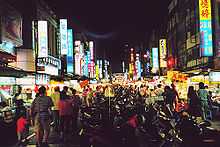Kaohsiung
| Kaohsiung 高雄 | |||
|---|---|---|---|
| Special municipality | |||
高雄市 · Kaohsiung City | |||
 | |||
| |||
| Nickname(s): The Harbor City (Gangdu), The Maritime Capital, The Waterfront City | |||
.svg.png) | |||
 | |||
| Coordinates: 22°38′N 120°16′E / 22.633°N 120.267°ECoordinates: 22°38′N 120°16′E / 22.633°N 120.267°E | |||
| Country |
| ||
| Region | Southern Taiwan | ||
| City seat |
Lingya District and Fengshan District | ||
| Government | |||
| • Mayor | Chen Chu (DPP) | ||
| • Deputy Mayor | Liu Shih-fang[1] | ||
| Area | |||
| • Total | 2,946.2527 km2 (1,137.5545 sq mi) | ||
| Rank 4 | |||
| Elevation | 9 m (30 ft) | ||
| Population (2010) | |||
| • Total | 2,769,072 | ||
| • Density | 940/km2 (2,400/sq mi) | ||
| Rank 2 | |||
| Time zone | Asia/Taipei (UTC+8) | ||
| Postal code | 800–852 | ||
| Area code(s) | (0)7 | ||
| ISO 3166 code | TW–KHH | ||
| Districts | 38 | ||
| Website | www.kcg.gov.tw/EN | ||
Kaohsiung (Chinese: 高雄; pinyin: Gāoxióng; Pe̍h-ōe-jī: Ko-hiông; old names: Takao, Takow, Takau) officially Kaohsiung City, is one of the five special municipalities under the administration of Taiwan . Located in southern-western Taiwan and facing the Taiwan Strait, it is by area the largest municipality, at 2,947.62 km2 (1,138.08 sq mi), and second most populous (by urban area) with a population of approximately 2.77 million. Since its start at 17th century, Kaohsiung has grown from a small trading village, into the political, economic, transportation, manufacturing, refining, shipbuilding, and industries centers of southern Taiwan. It is a global city with sufficiency as categorized by GaWC in 2012.[2]
The Kaohsiung International Airport serving the city is the second largest airport in Taiwan. The Port of Kaohsiung is the largest harbor in Taiwan, but not officially part of Kaohsiung City. The southern terminal of the Sun Yat-sen Freeway is in Kaohsiung. For north-south travel on railway, the city is served by the Taiwan Railway Administration stations of Western Line and Pingtung Line. The Taiwan High Speed Rail also provides fast and frequent railway connection to Taipei City. The Kaohsiung Mass Rapid Transit, the city's subway system, launched in early 2008. Kaohsiung was the host city of the 2009 World Games, a multi-sport event primarily composed of sports not featured in the Olympic Games. The city is also home to the Republic of China Navy fleet headquarter and academy.
History
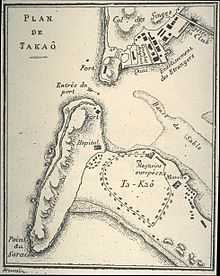
Founded near the end of the 17th century, the village was known as Takau (Chinese: 打狗; pinyin: Dǎgǒu; Pe̍h-ōe-jī: Táⁿ-káu; literally "beat the dog") in the Hoklo language spoken by most of the early immigrants. The name originates from the Makatao language of the local aboriginal tribe and translates as "bamboo forest". The Dutch established Fort Zeelandia in 1624 and defeated the local tribes in 1635. They called the place Tancoia. The Dutch were later expelled by the Kingdom of Tungning government founded by Ming Dynasty loyalists of Koxinga in 1662. Zheng Jing, the son of Koxinga, renamed the village Wannian Zhou (simplified Chinese: 万年洲; traditional Chinese: 萬年州; pinyin: Wàn Nián Zhōu; literally "region of ten thousand years") in 1664. The name was restored to Takau in the late 1670s, when the town expanded dramatically with immigrants from mainland China. In 1684 the Qing Dynasty annexed Taiwan and renamed the town Fengshan County (simplified Chinese: 凤山县; traditional Chinese: 鳳山縣; pinyin: Fèngshān xiàn; literally "phoenix mountain"), considering it a part of Taiwan Prefecture. It was first opened as a port during the 1680s.
In 1895, Taiwan was ceded to Japan as part of the Treaty of Shimonoseki. It was during this period that the city's name was changed from 打狗 (Taiwanese: Táⁿ-káu) to 高雄 (romaji: Takao). While the sound remained more or less the same when pronounced in Japanese, the literal meaning of the name changed from "Beating Dog" to "High Hero". The Japanese developed Takao, especially the harbour. An important military base and industry center, the city was heavily bombed by Task Force 38 and FEAF during 1944–1945.
After control of Taiwan was handed to the government of the Republic of China in 1945, the official romanization of the city name came to be "Kao-hsiung", based on the Wade–Giles romanization of the Mandarin reading of the kanji name.[3] Kaohsiung was upgraded to a special municipality on July 1, 1979, by the Executive Yuan, which approved this proposal on November 19, 1978. The Kaohsiung Incident took place in Kaohsiung on December 10, 1979.
On December 25, 2010, it merged with Kaohsiung County of Taiwan Province to form a larger municipality.[4]
Geography

The city sits on the southwestern coast of Taiwan facing the Taiwan Strait. The downtown areas are centered around Kaohsiung Harbor with the island of Qijin on the other side of the harbor acting as a natural breakwater. The Love River (or Ai River) flows into the harbor through the Old City and downtown. Zuoying Military Harbor lies to the north of Kaohsiung Harbor and the city center. Kaohsiung's natural landmarks include the coral mountains Ape Hill, Shoushan and Banpingshan.
Climate
Kaohsiung is located within a degree to the south of the Tropic of Cancer. The climate is tropical, specifically a tropical monsoon climate (Köppen Am), with monthly mean temperatures in the range of 19.3 to 29.2 °C (66.7 to 84.6 °F), and relative humidity between 71 and 81%. Average annual rainfall is 1,885 millimetres (74.2 in), focused primarily from June to August. At more than 2210 hours of bright sunshine, the city is one of the sunniest areas in Taiwan.[5]
| Climate data for Kaohsiung International Airport (2012-2013) | |||||||||||||
|---|---|---|---|---|---|---|---|---|---|---|---|---|---|
| Month | Jan | Feb | Mar | Apr | May | Jun | Jul | Aug | Sep | Oct | Nov | Dec | Year |
| Average high °C (°F) | 25.5 (77.9) |
27.5 (81.5) |
28.5 (83.3) |
29.5 (85.1) |
31.0 (87.8) |
32.0 (89.6) |
33.0 (91.4) |
31.5 (88.7) |
32.0 (89.6) |
30.0 (86) |
28.5 (83.3) |
26.0 (78.8) |
29.58 (85.25) |
| Daily mean °C (°F) | 20.0 (68) |
22.0 (71.6) |
24.5 (76.1) |
26.0 (78.8) |
27.5 (81.5) |
29.0 (84.2) |
29.0 (84.2) |
28.5 (83.3) |
28.0 (82.4) |
26.0 (78.8) |
24.5 (76.1) |
21.0 (69.8) |
25.5 (77.9) |
| Average low °C (°F) | 16.0 (60.8) |
18.0 (64.4) |
20.0 (68) |
23.0 (73.4) |
25.0 (77) |
26.0 (78.8) |
26.0 (78.8) |
25.5 (77.9) |
25.0 (77) |
23.0 (73.4) |
21.0 (69.8) |
17.0 (62.6) |
22.13 (71.83) |
| Source: Wunderground [6] | |||||||||||||
| Climate data for Kaohsiung City (1981–2010) | |||||||||||||
|---|---|---|---|---|---|---|---|---|---|---|---|---|---|
| Month | Jan | Feb | Mar | Apr | May | Jun | Jul | Aug | Sep | Oct | Nov | Dec | Year |
| Average high °C (°F) | 23.9 (75) |
24.7 (76.5) |
26.8 (80.2) |
29.1 (84.4) |
30.8 (87.4) |
31.6 (88.9) |
32.4 (90.3) |
31.9 (89.4) |
31.4 (88.5) |
30.0 (86) |
27.8 (82) |
25.0 (77) |
28.8 (83.8) |
| Daily mean °C (°F) | 19.3 (66.7) |
20.3 (68.5) |
22.6 (72.7) |
25.4 (77.7) |
27.5 (81.5) |
28.6 (83.5) |
29.2 (84.6) |
28.7 (83.7) |
28.2 (82.8) |
26.7 (80.1) |
24.1 (75.4) |
20.7 (69.3) |
25.11 (77.21) |
| Average low °C (°F) | 15.7 (60.3) |
16.7 (62.1) |
19.2 (66.6) |
22.4 (72.3) |
24.8 (76.6) |
25.9 (78.6) |
26.4 (79.5) |
26.1 (79) |
25.5 (77.9) |
24.0 (75.2) |
20.9 (69.6) |
17.1 (62.8) |
22.06 (71.71) |
| Rainfall mm (inches) | 16.0 (0.63) |
20.5 (0.807) |
38.8 (1.528) |
69.8 (2.748) |
197.4 (7.772) |
415.3 (16.35) |
390.9 (15.39) |
416.7 (16.406) |
241.9 (9.524) |
42.7 (1.681) |
18.7 (0.736) |
16.2 (0.638) |
1,884.9 (74.21) |
| Avg. rainy days (≥ 0.1 mm) | 3.2 | 3.7 | 4.0 | 5.8 | 9.3 | 13.8 | 12.9 | 16.3 | 11.2 | 3.5 | 2.6 | 2.3 | 88.6 |
| % humidity | 72.7 | 73.5 | 73.2 | 75.1 | 76.9 | 80.1 | 78.7 | 80.5 | 78.9 | 75.5 | 73.3 | 71.9 | 75.9 |
| Mean monthly sunshine hours | 174.7 | 165.8 | 187.0 | 189.1 | 198.5 | 199.9 | 221.4 | 193.7 | 175.7 | 182.4 | 162.2 | 161.8 | 2,212.2 |
| Source: Central Weather Bureau [5] | |||||||||||||
Cityscape

Politics
| Kaohsiung City | |||||||||||||||||||||||||||||||
| Chinese name | |||||||||||||||||||||||||||||||
|---|---|---|---|---|---|---|---|---|---|---|---|---|---|---|---|---|---|---|---|---|---|---|---|---|---|---|---|---|---|---|---|
| Chinese | 高雄市 | ||||||||||||||||||||||||||||||
| Literal meaning | High Bravery | ||||||||||||||||||||||||||||||
| |||||||||||||||||||||||||||||||
| Japanese name | |||||||||||||||||||||||||||||||
| Kanji | 高雄市 | ||||||||||||||||||||||||||||||
| Kana | たかおし | ||||||||||||||||||||||||||||||
| |||||||||||||||||||||||||||||||
Government
Kaohsiung is sometimes seen as the political mirror image of Taipei. While northern Taiwan leans towards the Pan-Blue Coalition in the state-level elections, southern Taiwan leaned towards the Pan-Green Coalition since late 1990s, and Kaohsiung is no exception. Frank Hsieh of the Democratic Progressive Party was reelected twice as Mayor of Kaohsiung, where he was widely credited for transforming the city from an industrial sprawl into an attractive modern metropolis. Hsieh resigned from the office of mayor to take up the office of Premier of the Republic of China in 2005. The last municipal election, held on December 9, 2006, resulted in a victory for the Democratic Progressive Party's candidate Chen Chu, the first elected female mayor of special municipality in Taiwan, defeating her Kuomintang rival and former deputy mayor, Huang Chun-ying.
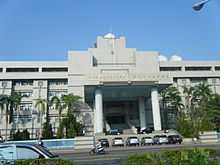 Kaohsiung District Court |
Subdivisions
Kaohsiung is directly divided into 38 districts (區), each district is divided into villages (里), there are 651 villages, each village is subdivided into neighborhoods (鄰), there are 18,584 neighborhoods.
- Note: For the inconsistency of the romanization systems in Taiwan. This table was made in a sortable form, contains both Hanyu Pinyin (the official standard of the central government of ROC), and Tongyong Pinyin (the official standard of the Kaohsiung City Government). The major order of districts referred to the code of administrative area. Kaohsiung has the most numbers of districts among other special municipalities in Taiwan.
|
 .svg.png) A map of Kaohsiung's population density Fengshan Jiading Jiaxian Liugui Namaxia Nanzi Qiaotou Qishan Taoyuan Xiaogang Qianzhen Qijin Tainan City Administrative Divisions of Kaohsiung |
Part of South China Sea Islands are administered by Kaohsiung City as parts of Qijin District:
- Taiping Island (Chinese: 太平島; pinyin: Tàipíng dǎo) and Zhongzhou Reef (Chinese: 中洲礁; pinyin: Zhōngzhōu jiāo) in the Spratly Islands
- Dongsha Islands or Pratas Islands (Chinese: 東沙群島; pinyin: Dōngshā Qúndǎo)
Economy


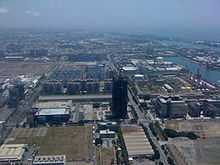
Intensive settlement began in earnest in the late 17th century, when the place was known as Ch'i-hou. Opened in 1863 as a treaty port, subsidiary to the port of Anping farther north on the coast, Kaohsiung became a customs station in 1864 and then gradually became an important port for the southern Taiwan coastal plain.
Kaohsiung's real economic and strategic importance began under the Japanese occupation (1895–1945). The Japanese needed a good port in southern Taiwan to serve those designated areas that were to become a major source of raw materials and food for Japan, and Kaohsiung was chosen. It became the southern terminus of the main north-south railway line, and from 1904 to 1907 extensive harbor works were undertaken. In 1920 the port was given the name Takao and the area became a municipality in 1920.
Before and during World War II it handled a growing share of Taiwan's agricultural exports to Japan, and was also a major base for Japan's campaigns in Southeast Asia and the Pacific, and extremely ambitious plans for the construction of a massive modern port were drawn up. Toward the end of the war, too, the Japanese promoted some industrial development at Kaohsiung, establishing an aluminum industry based on the abundant hydroelectric power produced by the Jih-Yueh Lake project in the mountains.
After it came under Chinese Nationalist administration in 1945, Kaohsiung developed rapidly. The port, badly damaged in World War II, was restored. It also became a fishing port for boats sailing to Philippine and Indonesian waters. Largely because of its climate, Kaohsiung has overtaken Keelung as Taiwan's major port.
Today as a major international port and industrial city in the southwest of the country, Kaohsiung is the most rapidly developing urban center of Taiwan. With an area of 2,946 km2, it has a large natural harbor, with the entrance in recent years being expanded, rock-excavated, and dredged.
As an exporting center, Kaohsiung serves the rich agricultural interior of southern Taiwan, as well as the mountains of the southeast. Major raw material exports include rice, sugar, bananas, pineapples, peanuts (groundnuts), and citrus fruits. The 2,200 hectare Linhai Industrial Park, on the waterfront, was completed in the mid-1970s and includes a steel mill, shipyard, petrochemical complex, and other industries. The city has an oil refinery, aluminum and cement works, fertilizer factories, sugar refineries, brick and tile works, and salt-manufacturing and papermaking plants. Designated an export-processing zone in the late 1970s, Kaohsiung has succeeded in attracting foreign investment to process locally purchased raw materials for export. There is also a large canning industry that processes both fruit and fish.
The ongoing Nansing Project is an ambitious plan to reclaim 250 hectares of land along the coast by 2011.[7] The Kaohsiung Harbor Bureau plans to buy 49 hectares of the reclaimed land to establish a solar energy industrial district which would be in the harbor's free trade zone.[7]
The GDP in nominal terms of the city of Kaohsiung is estimated to be around $45 billion US, and $90 billion for the metropolitan region. As of 2008, the GDP per capita in nominal terms of the city of Kaohsiung is approximately US$ 24,000.[8]
Transportation

Port of Kaohsiung
A major port, through which pass most of Taiwan's marine imports and exports, is located at the city but is not managed by the city government.Also known as the "Harbour Capital" of Taiwan, Kaohsiung has always had a strong link with the ocean and maritime transportation. Ferries play a key role in everyday transportation, and often play the role that buses do in other cities, especially for transportation across the harbour. With five terminals and 23 berths, the Port of Kaohsiung is Taiwan's largest container port and the 6th largest in the world.[9] In 2007 the port reached its handling capacity with a record trade volume of 10.2 million twenty-foot equivalent units (TEU).[10] A new container terminal is under construction, increasing future handling capacity by 2 million TEU by 2013.[10]
The Port of Kaohsiung is not officially a part of Kaohsiung City, instead it is administrated by Kaohsiung Port Authority, under Ministry of Transportation. There is a push for Kaohsiung City to annex the Port of Kaohsiung in order to facilitate better regional planning.
Kaohsiung is one of the biggest ports in the world for importing shark fins, sold at high prices in the restaurants and shops of Taiwan and China. They are brought in from overseas and are placed out to dry in the sun on residential rooftops near the port.
Kaohsiung International Airport
Kaohsiung City is also home to Taiwan's second largest airport, the Kaohsiung International Airport, which is located in the Siaogang District in southern Kaohsiung City.
Rapid Transit
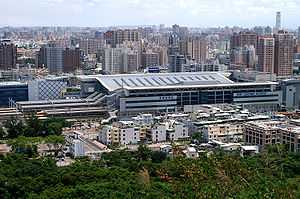
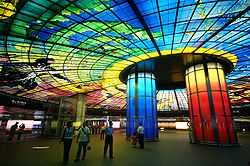
Kaohsiung Mass Rapid Transit opened for revenue service in March 2008. A light rail line (Circular Line) that circles central Kaohsiung City is under construction and will open in 2015.
Railway
The city is served by the Taiwan Railway Administration's Western Line and Pingtung Line. Taiwan High Speed Rail also serves Kaohsiung City via its new Zuoying Station in northern Kaohsiung City. Future plans include extending high speed rail to the new Kaohsiung Station in the city centre. The new Kaohsiung Station will be an underground station, replacing the current ground level station. Additionally, these two stations will also be served by Red line of Kaohsiung Rapid Transit System when the line opened for revenue service in early 2008.
Culture & Art
Kaohsiung has rich resources of the ocean, mountains and forests, take shape a diverse combination and different communities, the formation of a very active and multi-faceted nature of art and culture in the streets of Kaohsiung, everywhere you can see the beauty and grace of its public infrastructure, public art and city architecture.The field of public transport in Kaohsiung show a city of aesthetics. Unique design from MRT station to the city's public works of art, city space into an art gallery. "Dome light" in the concourse of Formosa Boulevard Station of Kaohsiung MRT is one of the world's largest public glass works of art, and it is the public art chanticleer representative works in Kaohsiung.[11]
Sports

Kaohsiung has Southern Taiwan region's most comprehensive sports facilities, as well as the country's largest stadium. Kaohsiung National Stadium (the Main Stadium of 2009 World Games) and Kaohsiung Arena as the representative of sports facilities in Kaohsiung. National Stadium is Taiwan's largest international-class stadium, maximum capacity is 55,000 seats.
Kaohsiung hosted the 2009 World Games. Nearly 6,000 athletes, officials, coaches, referees and others from 103 countries participated in the 2009 Kaohsiung World Games. Kaohsiung in 2007, 2009 and 2011 for three consecutive years, the number of gold medals and total medals of the National Games were the first place in the country.
Attractions
- Love River (愛河)
- Urban Spotlight Arcade (城市光廊)
- Tuntex Sky Tower (東帝士85國際廣場)
- World Games Stadium (世運會主場館)
- Liuhe Night Market (六合夜市)
- Zuoying's Lotus Lake (左營蓮池潭)
- Kaohsiung Museum of Fine Arts (高雄市立美術館)
- Cihou Fort (旗後砲台)
- Qijin Ferry (旗津渡輪)
- Old City of Zuoying (鳳山舊城)
- Chai Mountain (柴山)
- Ban Ping Mountain (半屏山)
- Shou Shan Zoo (壽山動物園)
- Former British Consulate at Takao (前清英國領事館)
- Holy Rosary Cathedral (前金天主堂)
- National Science and Technology Museum (國立科學工藝博物館)
- Kaohsiung Museum of History (高雄市立歷史博物館)
- Old Kaohsiung Railway Station (台鐵舊高雄車站)
- Siziwan Scenic Area (西子灣風景區)
- Kaohsiung Astronomical Museum (高雄市立天文教育館)
- Kaohsiung Hakka Cultural Museum (高雄市客家文物館)
- Chang-Gu World Trade Center (長谷世貿大樓)
- Tower of Light (光之塔)
- Kaohsiung Mosque (高雄清真寺)
- Singuang Ferry Wharf (新光碼頭)
- True Love Ferry Pier (真愛碼頭)
- Kaohsiung Fisherman's Wharf (高雄港漁人碼頭)
- Sinsing Night Market (新興夜市)
- Dragon and Tiger Pagodas
- Spring and Autumn Pavilions
Education

Kaohsiung has a number of colleges and junior colleges offering training in commerce, education, maritime technology, medicine, modern languages, nursing, and technology.
- Kaohsiung Medical University (高雄醫學大學)
- National Kaohsiung First University of Science and Technology (國立高雄第一科技大學)
- National Kaohsiung Normal University (國立高雄師範大學)
- National Kaohsiung University of Applied Sciences (國立高雄應用科技大學)
- National Kaohsiung Marine University (國立高雄海洋科技大學)
- National Kaohsiung University of Hospitality and Tourism (國立高雄餐旅大學)
- National Sun Yat-sen University (國立中山大學)
- National University of Kaohsiung (國立高雄大學)
- I-Shou University (義守大學)
- Wenzao Ursuline College of Languages (文藻外語學院)
- Kivam Junior High School (優佳雙語學校)
- Kaohsiung Municipal Kaohsiung Senior High School (高雄市立高雄高級中學)
- Municipal Kaohsiung Girls' Senior High School (高雄市立女子高級中學)
- Affiliated Senior High School of National Kaohsiung Normal University
- Kaohsiung American School (高雄美國學校)
- I-Shou International School (義大國際高級中學)
Conferences and Events
The Kaohsiung World Trade Exhibition and Convention Center, built by the Kaohsiung City Government, is expected to be completed by end-2013, and will include an exhibition space for 1,500 booths, and a convention hall for 2,000 pax. The center will host the first Taiwan International Boat Show in 2014.[12]
Sister cities and twin towns
Kaohsiung is twinned with the following locations.
|
|
|
See also
- Administrative divisions of the Republic of China
- Kaohsiung City Council
- Kaohsiung City Government
- List of cities in Taiwan
- Taipei
References
- ↑ "Sister-city agreement falls apart in hours". Taipei Times. 2013-07-20. Retrieved 2013-07-27.
- ↑ "The World According to GaWC 2012". Lboro.ac.uk. 2014-01-13. Retrieved 2014-02-01.
- ↑ What's in changing a name? Taiwan Journal Vol. XXVI No. 19 May 15, 2009 "...while name Kaohsiung is technically the Mandarin pronunciation of the Japanese written version of a Holo Taiwanese rendition of an old aboriginal name..."
- ↑ http://taiwanjournal.nat.gov.tw/ct.asp?xitem=53774&ctnode=413&mp=9
- ↑ 5.0 5.1 "Climate". Central Weather Bureau.
- ↑ "Climate". Wunderground.
- ↑ 7.0 7.1 "Kaohsiung City to open solar energy industrial zone". Focus Taiwan News Channel. 2010-06-27. Retrieved 2010-07-09.
- ↑ "Taipei City Has Second-highest Per Capita GDP in Asia: TIER | CENS.com - The Taiwan Economic News". CENS.com. 2009-03-19. Retrieved 2010-07-08.
- ↑ Review of Maritime Transport 2004. New York: United Nations. 2005. ISBN 92-1-112645-2.
- ↑ 10.0 10.1 Dale, Jamie (2008-01-17). "Kaohsiung container port hits full capacity". Lloyd's List Daily Commercial News (Informa Australia). p. 16.
- ↑ "Art&Culture Kaohsiung City Government". Kcg.gov.tw. Retrieved 2013-07-27.
- ↑ "Kaohsiung’s new venue". TTGmice. Retrieved 18 January 2013.
External links
| Find more about Kaohsiung at Wikipedia's sister projects | |
| |
Definitions and translations from Wiktionary |
| |
Media from Commons |
| |
Quotations from Wikiquote |
| |
Source texts from Wikisource |
| |
Textbooks from Wikibooks |
| |
Travel guide from Wikivoyage |
| |
Learning resources from Wikiversity |
- Kaohsiung City Government official website (Chinese)
- Kaohsiung City Government official website (English)
| ||||||||||||||||||||
| ||||||||||||||||||||||||
| |||||


.JPG)






